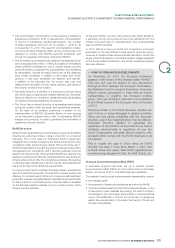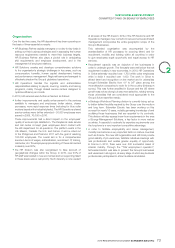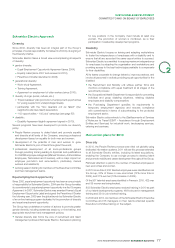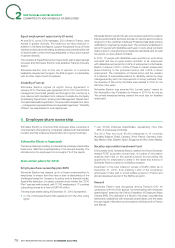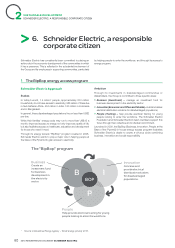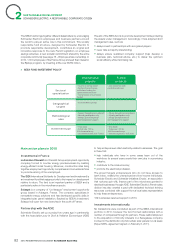APC 2010 Annual Report Download - page 74
Download and view the complete annual report
Please find page 74 of the 2010 APC annual report below. You can navigate through the pages in the report by either clicking on the pages listed below, or by using the keyword search tool below to find specific information within the annual report.
SUSTAINABLE DEVELOPMENT
2COMMITTED TO AND ON BEHALF OFEMPLOYEES
>
5. Committed to and on behalf
ofemployees
1 Overview
Challenges and Commitments
Schneider Electric’s people are critical to its success. The Group
motivates its employees and promotes involvement by making the
most of diversity, supporting professional development, and ensuring
safe, healthy working conditions.
Schneider Electric’s HR policy is founded on a strong sense of
commitment and shared services:
•all of the Group entities participate in the drawing up of HR policies
and in their application. This guarantees coherence and facilitates
consideration for local economic, legislative and cultural realities;
•all employees are treated equally, notably with regard to job
vacancies, mobility, training, remuneration, safety and healthcare;
•particular emphasis is placed on communicating the Group’s
broad strategic plans to the employees in order to enhance
individual participation;
•training is also a priority so that employees have the opportunity
to adapt to developments within the Company.
A key part of the Group’s overall transformation is the development
within the HR department in 2010. To ensure flexibility and
accompany the changing requirements of the Group’s activity
(growth, acquisitions, restructuring, etc.), the HR division was
reorganised in 2009 into three broad categories: HR Business
Partner, HR Solutions and HR Operations (see page 73 Organisation).
These three units are linked to the centralised information system,
Bridge HR, which aligns all of the HR processes worldwide and
provides a global database for shared talent management. Bridge
HR was rolled out for the Group’s white collar employees in 2010. All
Group employees are to be covered by the end of 2011.
Schneider Electric encourages each employee to actively manage
their own career in collaboration with their line manager, their HR
manager and using the tools provided on the Group’s intranet. This
allows each employee to play a key role in their own performance
and in their advancement.
One of the HR Department’s goals is to promote effi ciency and
productivity (over 20% of productivity between 2008 and 2010): this
involves reducing costs while providing effi cient services and meeting
the needs of the employees and their managers.
Objectives and Results 2010
Three priority objectives were set in the Planet and Society
Barometer for the duration of the One program (2009-2011):
Objectives for Year-End-2011 2010 2009 2008
1. 10% annual decrease in the frequency rate of occupational accidents -44% ▲-32% -
2. 14 points increase in the company’s employee recommendation score +16 ▲0-
3. 2,000 employees trained on energy management solutions 239 ▲40* 0
* In the previous Annual Report, the indicator measured the people having attended energy management solution courses (2,655 at the
end of 2009). Since the beginning of 2010, only the people having completed the entire educational course offi cially recognised by a
certifi cation are recorded by the indicator.
The 2008 performance serves as a starting value for the Planet & Society Barometer One Program between 2009 and 2011.
▲ 2010 Audited Indicators
Please refer to pages 88 to 90 for the methodological presentation of indicators and the following pages for the analysis of the results
(pages74 for indicator 1, 75 for indicator 2 and 76 for indicator 3).
End 2010:
•Schneider Electric reduces by 44% the rate of work accidents,
compared with end-2009;
•the recommendation score given to the Company by employees
rises by 16 points, compared with the starting score;
•the Group trains 239 experts in energy management.
The analysis of results is presented in the sub-chapters “Safety
and health of employees”, “Employee commitments” and “Talent
development and training”, below.
2010 REGISTRATION DOCUMENT SCHNEIDER ELECTRIC72









